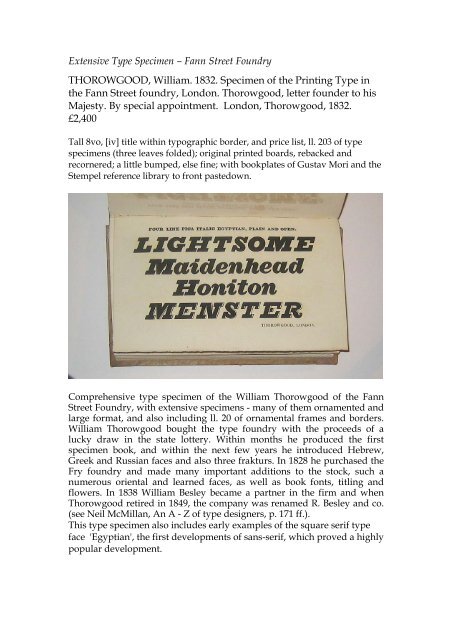Extensive Type Specimen – Fann Street Foundry - Schulz-Falster ...
Extensive Type Specimen – Fann Street Foundry - Schulz-Falster ...
Extensive Type Specimen – Fann Street Foundry - Schulz-Falster ...
You also want an ePaper? Increase the reach of your titles
YUMPU automatically turns print PDFs into web optimized ePapers that Google loves.
<strong>Extensive</strong> <strong>Type</strong> <strong>Specimen</strong> <strong>–</strong> <strong>Fann</strong> <strong>Street</strong> <strong>Foundry</strong><br />
THOROWGOOD, William. 1832. <strong>Specimen</strong> of the Printing <strong>Type</strong> in<br />
the <strong>Fann</strong> <strong>Street</strong> foundry, London. Thorowgood, letter founder to his<br />
Majesty. By special appointment. London, Thorowgood, 1832.<br />
£2,400<br />
Tall 8vo, [iv] title within typographic border, and price list, ll. 203 of type<br />
specimens (three leaves folded); original printed boards, rebacked and<br />
recornered; a little bumped, else fine; with bookplates of Gustav Mori and the<br />
Stempel reference library to front pastedown.<br />
Comprehensive type specimen of the William Thorowgood of the <strong>Fann</strong><br />
<strong>Street</strong> <strong>Foundry</strong>, with extensive specimens - many of them ornamented and<br />
large format, and also including ll. 20 of ornamental frames and borders.<br />
William Thorowgood bought the type foundry with the proceeds of a<br />
lucky draw in the state lottery. Within months he produced the first<br />
specimen book, and within the next few years he introduced Hebrew,<br />
Greek and Russian faces and also three frakturs. In 1828 he purchased the<br />
Fry foundry and made many important additions to the stock, such a<br />
numerous oriental and learned faces, as well as book fonts, titling and<br />
flowers. In 1838 William Besley became a partner in the firm and when<br />
Thorowgood retired in 1849, the company was renamed R. Besley and co.<br />
(see Neil McMillan, An A - Z of type designers, p. 171 ff.).<br />
This type specimen also includes early examples of the square serif type<br />
face 'Egyptian', the first developments of sans-serif, which proved a highly<br />
popular development.
'Robert Thorne was originally apprentice to Cottrell, and in 1794 acquired<br />
his foundry, … Thorne died in 1820 and his foundry, then <strong>Fann</strong> <strong>Street</strong>, was<br />
bought by William Thorowgood. … The <strong>Fann</strong> <strong>Street</strong> foundry descended to<br />
the Reeds, and it was in this firm that Talbot Baines Reed acquired his<br />
interest in the history of English letter foundries' (Berry & Johnson pp. 65-<br />
66).<br />
Thorowgood, together with Thorne, Figgins and Fry were avid followers<br />
of new style type faces, derided by Hansard and Updike as 'fat-face' fonts.<br />
[Provenance:] From the collection of the type historian and practician<br />
Gustav Mori (1872-1950), employee of the Stempel type foundry, and from<br />
the collection of the Stempel AG, the famous German printing house and<br />
type foundry.<br />
See Berry & Johnson, Catalogue pp. 65ff.; Bigmore-Wymann. III, 10; St. Bride<br />
Catalogue p. 891; Updike II, 196 (all without this type specimen); see Talbot Baines<br />
Reed, The Old English Letter Foundries, ed. By A. F. Johnson, 1952.
















